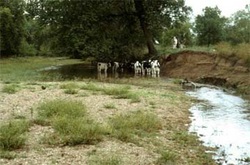Pasture Management

Agricultural animals are a source of fecal coliform loading in streams through direct and indirect activities. Animals with access to the streams can directly deposit feces into streams or onto their banks; animal feces can also be deposited in fields and be transported via overland flow during rain events. Additionally, when cattle access streams, they tend to trample the stream bank and beds, which results in sediment and stream instability.
This project consists of implementing pasture management practices that will reduce livestock interaction with the creek, and improve water quality. Techniques to lessen this issue include:
1. Livestock exclusion fencing or hedgerows
2. Fenceline feeding stations
3. Rotational grazing or other improved grazing methods
4. Establishment of alternative drinking water source(s)
5. Limited access practices
6. Installation of hardened access points for drinking water consumption
7. Similar practices that provide water quality benefits
If you would like to get involved with a project like this, contact the BWC.
This project consists of implementing pasture management practices that will reduce livestock interaction with the creek, and improve water quality. Techniques to lessen this issue include:
1. Livestock exclusion fencing or hedgerows
2. Fenceline feeding stations
3. Rotational grazing or other improved grazing methods
4. Establishment of alternative drinking water source(s)
5. Limited access practices
6. Installation of hardened access points for drinking water consumption
7. Similar practices that provide water quality benefits
If you would like to get involved with a project like this, contact the BWC.

